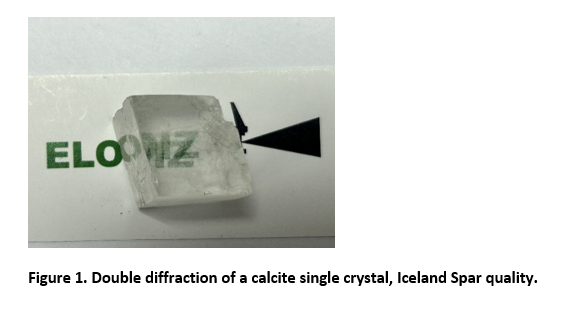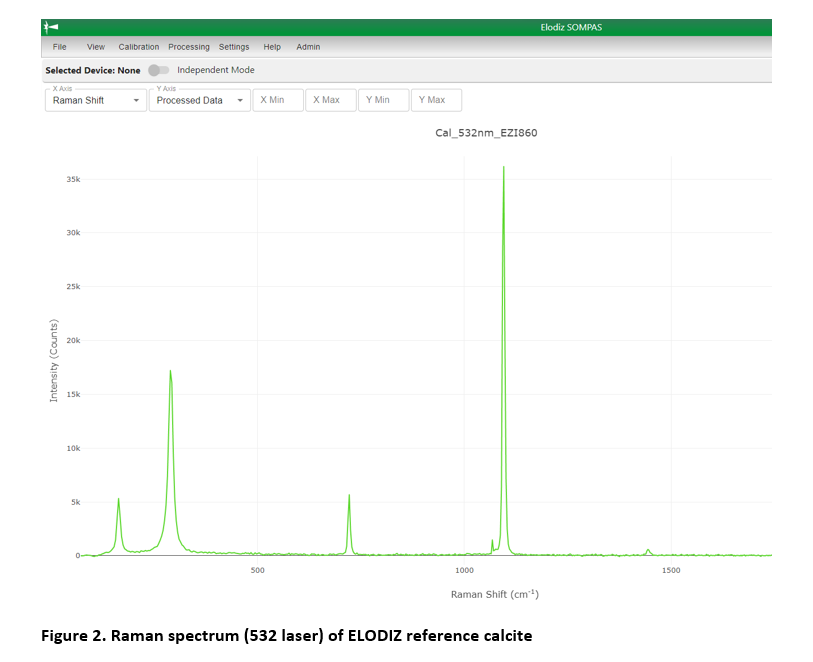Calcite as a Reference Material for Raman Spectroscopy
by Dr Enrique Lozano
Overview
Calcite is a calcium carbonate mineral. It is the most stable of the three crystalline known polymorphic forms of anhydrous calcium carbonate (CaCO3), with a trigonal rhombohedral crystal structure. The other two are Aragonite and Vaterite.1
Single crystals of calcite (“Iceland Spar”) are used in optics due to their unique properties:
1) they are easily accessible and abundant in nature,
2) they are stable and can be polished to optics standards (calcite displays an optical property called birefringence, i.e. double refraction).

Calcite is most broadly used as a polarizer, i.e. an optical filter that allows certain light waves to go through while blocking others. Calcite crystals are used to
separate unpolarized light into two separate plane polarized beams. An unpolarized beam that enters a birefringent crystal is separated into two different polarized plane rays. These are referred to as the ordinary (o-ray) and extraordinary (e-ray) rays.2 Calcite polarizers form a part of Glan-Taylor Calcite Prism, one of the most common modern polarizing prisms, specifically designed to handle high-energy lasers. In addition to this, calcite also finds its use as a reference material in spectroscopy and in particular in Raman spectroscopy, as mentioned in e.g. ASTM standards for Raman verification or H2020 CHARISMA protocols for harmonisation of Raman Spectroscopy.3,5
Calibration of Raman Shifts and Resolution Assessment
Calcite exhibits a limited number of Raman bands, but these are very sharp and well-defined, which makes them easy to identify and measure. The resolution of a Raman spectrometer is crucial for the inter-comparability of spectra obtained among varying spectrometer systems. The narrow and reproducible lines obtained in the calcite Raman spectrum can help calculate Raman spectral resolution making calcite an excellent reference material.3

Calcite has a well-known and distinctive Raman spectrum, with a strong peak at 1086 cm-1 and several weaker peaks and satellites.4 By comparing the measured Raman shifts of calcite with the theoretical values, the accuracy and precision of the Raman spectrometer can be evaluated and adjusted.1,4
ELODIZ provides mounted and unmounted calcite crystals (PN: EL0-6013) that are certified for use in Raman spectroscopy calibration and verification.
For further information and to purchase, please visit Materials for Calibration – Elodiz.
References
- The Raman spectrum of CaCO3 polymorphs calcite and aragonite: https://pubs.aip.org/aip/jcp/article/140/16/164509/841990/The-Raman-spectrum-of-CaCO3-polymorphs-calcite-and
- Calcite Polarizers Selection Guide: Types, Features, Applications | GlobalSpec: https://www.globalspec.com/learnmore/optics_optical_components/optical_components/calcite_polarizers
- Standard Guide for Testing the Resolution of a Raman Spectrometer: https://www.astm.org/e2529-06r22.html
- The Raman spectrum of calcite and its interpretation: https://link.springer.com/article/10.1007/BF03045968
- H2020 Charisma – Project Overview: Project Overview — H2020 CHARISMA



